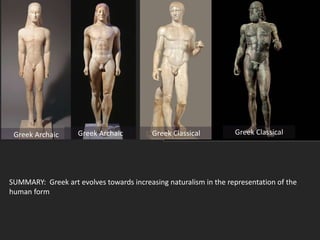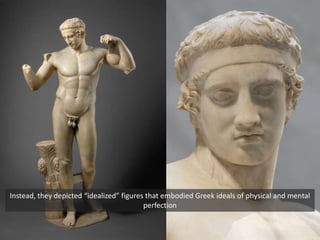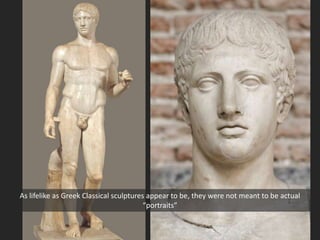True or false Classical sculpture was both naturalistic and idealistic. Classical sculpture was both naturalistic and idealistic Government assembly halls The first Christian churches were patterned after basilicas used by he Romans as.
Classical Greece 480-323 BCE.
. Classical Roman art differed from classical Greek art because Roman art focused on realism while Greek art focused on idealism. The scientific skill of Greek sculptors in showing. Classical Greek sculptors were more imaginative because the Enlightenment released them from the dogma of the pharoahs.
Classical Greek figures appear more relaxed than the rigid formal Egyptian and early Greek sculptural poses because _____. The Hellenistic art looked at how the. The sculpture of the Italian Renaissance comprises the approximate period between the late fourteenth and the early sixteenth century when Italian sculpture expressed a reaction against the aesthetic principles of Gothic and assimilating the influence of classical antiquity art humanism and rationalism developed a style that merged naturalistic and other idealistic elements into.
In the Classical period this conflict reached an apotheosis when the two forces were balanced against each other. Classical Greece also known as the Golden Age became fundamental both to the later Roman Empire and western civilization in philosophy politics literature science art and architecture. Access the answers to hundreds of Ancient Greek art questions that are explained in a way thats easy for you to understand.
Roman artists typically made realistic portraits and sculptures. Whether deliberately applied. Absolutely both in terms of composition and also of applique.
For Hegel Romantic Christian art was the high point of the history of art a history which he believed complete and closed. In the fallen warrior greece and the dying gaul roman copy both clearly represent a. Ancient Greek sculpture of the Classical period depicts beauty through the balance of naturalism and idealism.
The High Classical Greek art was more idealistic and it showed how the Greeks wanted to be portrayed and the Hellenisic art is much more realistic. Greek sculpture marked the height of Classical art and Romantic art grew with Christianity. The classical period characterized modifications in both the function and the style of the sculpture.
The only materials available to the Egyptian sculptors were stones that had a very. O It is your task to write an essay that explains how this sculpture demonstrates the Humanistic Rationalistic and Idealistic values of the Classical Greek era. A similar conflation can be found in the medium of classical sculpture which is both naturalistic and idealistic.
The Romans took many elements from Greek art but brought a more naturalistic and ostentatious style. The sculptures were generally polychrome except for works made in bronze. Ancient Greek sculpture represents a development from idealism to naturalism.
3 points QUESTION 25 1. Look up Painted Greek Sculpture just to start and know that then as now every surface has a finish. The origin of sculpture in Greek and Roman art can almost be divided into distinct categories- classical and idealistic vs naturalistic and emotional sculpture work.
Beautiful natural looking images of men and idealized images of Gods. Classical Greek sculpture is both naturalistic and idealistic. O Introduce quoted or paraphrased information with signal phrases and include a parenthetical citation with page or paragraph number.
The great Greek historian of the era Thucydides called the general and populist statesman Pericles Athenss first citizen. Art imitated the art of greeks but used a more naturalistic approach. At the end of your analysis include a Works.
Were Classical sculpture both naturalistic and idealistic. Where Greek statues and sculptures depict calm ideal figures in the nude Roman sculpture is highly decorative and more concerned with realistic depictions of individualsThe Romans took many elements from Greek art but brought a more naturalistic. Symbolic art for example was found in ancient Egypt.
The Greeks idealized the human form because much of their art was a. Indeed John Boardman describes the work of Polyclitus Fig 2 a sculptor who canonized the male athletic body in classical period art as ideally realistic Boardman 157. Classical Greek sculpture is both naturalistic and idealistic.
Poses seemed more naturalistic as shown by the Polykleitos of Diadumenos sculpture. Difference Between Hellenistic and Classical Art Hellenistic vs Classical Art When talking about Hellenistic and classical art both arts are known for displaying human anatomy. Classical greek sculptures became increasingly naturalistic and began to show the body as alive and capable of movement while maintaining an interest in portraying the ideal human anatomy Greek Architecture.
An example of this is the bust of Pericles by Kresilas. Art that was both Naturalistic and idealistic. Classical art that emphasized rational simplicity order and restrained emotion.
By signing up youll get thousands of step-by-step. Defined by a careful observation of nature a new concern for the mechanics of the body and the pursuit of ideal forms Classical Greek sculpture represents a radical departure from the compact forms and upright poses of Archaic male nudes. In Hellenistic art one can see that the art forms went beyond understanding human anatomy and looked at how the body moved and how it looked when in action.
The Greeks and Romans both represented gods and rulers in the form of statues a combination of religious and political influence. In Hegels analysis each style of art also had its paradigmatic art form. On the other hand much freedom could be seen in the Hellenistic art forms.
What was a fundamental difference between Greek classical sculpture and Greek Hellenistic sculpture.

On The Literature And Thought Of The German Classical Era 11 Laocoon In Germany Open Book Publishers

Classical Greek Sculpture Is Both Naturalistic And Idealistic True Or False Study Com

Form And Reality The Classical Greek Balance Of The Ideal And The Natural Disrecognized Space




0 comments
Post a Comment